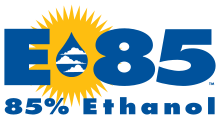
E85 is an abbreviation typically referring to an ethanol fuel blend of 85% ethanol fuel and 15% gasoline or other hydrocarbon by volume.
In the United States, the exact ratio of fuel ethanol to hydrocarbon may vary according to ASTM 5798 that specifies the allowable ethanol content in E85 as ranging from 51% to 83%.[1] This is due to the lower heating value of neat ethanol making it difficult to start engines in relatively cold climates without pre-heating air intake, faster cranking, or mixing varying fractions of gasoline according to climate. Cold starting in cold climates is the primary reason ethanol fuel is blended with any gasoline fraction.
In Brazil, ethanol fuel is neat at the pumps, hence flexible-fuel vehicles (FFV) including trucks, tractors, motorbikes and mopeds run on E100. The 85% fraction is commonly sold at pumps worldwide (outside the US), and when specifically supplied or sold as E85 is always 85% ethanol (at pumps or in barrel). Having a guaranteed ethanol fraction obviates the need for a vehicle system to calculate best engine tune accordingly to maximise performance and economy.
In countries like Australia where E85 is always[citation needed] 85% ethanol (and pump fuel with varying fractions is called "flex fuel"), performance motoring enthusiasts and motor racing clubs/championships use E85 extensively (without the need for any FFV certification)[citation needed]. Use of alcohol (ethanol and methanol) in motor racing history parallels the invention of the automobile, favoured due to inherent combustion characteristics such as high thermal efficiency, high octane rating, raised torque and with some advanced engines, better specific fuel consumption. In the United States, government subsidies of ethanol in general and E85 in particular have encouraged a growing infrastructure for the retail sale of E85, especially in corn growing states in the Midwest.[citation needed]
- ^ afdc.energy.gov, Handbook for Handling, Storing, and Dispensing E85 and Other Ethanol-Gasoline Blends. US Department of Energy. Retrieved October 2, 2013.